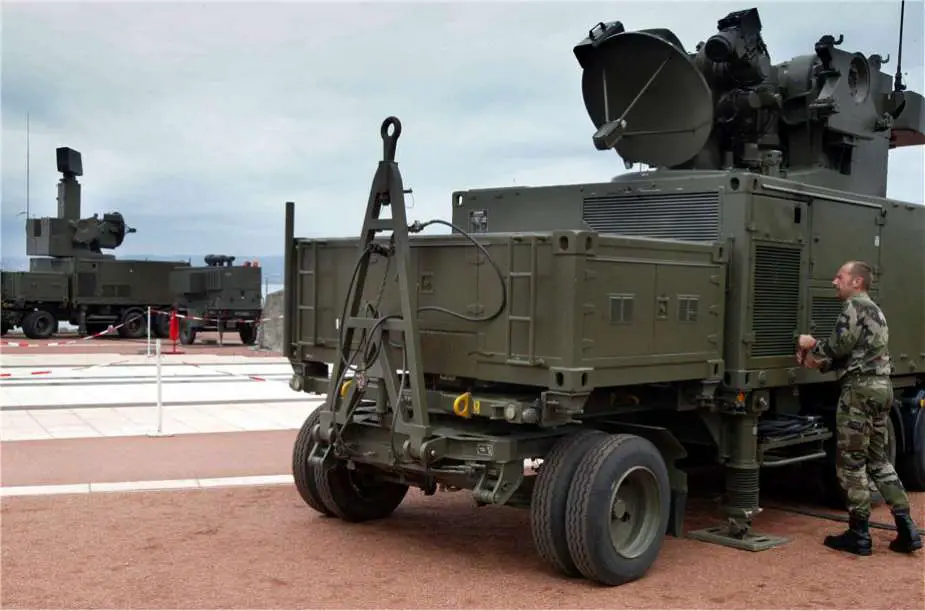- Army
- Conflicts in the world
- Israel - Iran conflict 2025
- Pakistan - India Conflict 2025
- Russia Ukraine War 2022
- Libya conflict day by day
- HAMAS - Israel War 2023
- Operation Serval in Mali French Army
- Sangaris operation Central African Republic
- Sangaris opération militaire République Centreafrique
- Ukraine - Russia conflict
- Syria conflict news
- Defence & Security Industry Technology
- Armies in the world
- Analysis Defense and Security Industry
- Conflicts in the world
- Navy
- Air
Russia Claims Destruction of Ukraine's First French-Donated Crotale NG & NASAMS Air Defense Systems
On December 24, 2023, the Russian Ministry of Defense reported that its forces have targeted and destroyed Ukrainian NASAMS and French-donated Crotale NG air defense systems stationed at the Starokonstantinov airfield in the Khmelnitsky region. This operation marks the first recorded instance of a Crotale NG air defense missile system being destroyed in combat.
Follow Army Recognition on Google News at this link

France has delivered two Crotale NG air defense systems to Ukraine. (Picture source Social Network)
As per the details provided by the Russian Ministry, a coordinated assault involving tactical aircraft, unmanned aerial vehicles, missile troops, and artillery units was launched. This operation not only neutralized the air defense systems but also inflicted damage on aircraft equipment, flight navigation facilities, and aviation ammunition stored at the Kanatovo airfields in the Kirovograd region and at Dnepr. The strategic impact of these strikes on Ukraine's air defense capabilities is expected to be significant.
The Russian army has not published photos showing the destruction of these air defense systems, and it is therefore difficult to verify whether the information is correct.
Since the beginning of the war, several countries have delivered NASAMS air defense systems to Ukraine. Belgium has contributed an undisclosed number of AIM-120 NASAMS missiles; Canada has supplied one NASAMS air defense battery along with AIM-120 missiles; Lithuania has provided two NASAMS launchers; the Netherlands has donated NASAMS missiles; Norway has dispatched two NASAMS batteries; the UK has given NASAMS missiles; and the United States has sent eight NASAMS batteries. Simultaneously, France has supplied Ukraine with two Crotale NG air defense batteries.
The importance of air dominance in military conflicts is a critical aspect. When discussing the situation between Russian and Ukrainian forces, air dominance plays a vital role in determining the outcome of engagements. The destruction of air defense capabilities is a strategic move that enables a military force to gain control over the airspace, reducing the risk to their aircraft and increasing their ability to conduct air operations, such as providing close air support to ground forces, conducting reconnaissance missions, and carrying out strategic bombing.
In the context of the conflict between Russia and Ukraine, if Russian forces were to successfully neutralize Ukrainian air defenses, it would grant them significant advantages. They would have greater freedom to operate their aircraft, potentially giving them an edge in both intelligence gathering and offensive operations. However, achieving air dominance is a complex task that involves not just destroying enemy air defenses but also maintaining a capable fleet of aircraft, having trained pilots, and employing sophisticated technology.
The NASAMS (National Advanced Surface-to-Air Missile System) is recognized for its impressive range of capabilities in air defense. Primarily, it utilizes the AIM-120 Advanced Medium-Range Air-to-Air Missiles (AMRAAM), which are capable of engaging targets at distances up to 25 kilometers (about 15.5 miles). This makes NASAMS effective for medium-range air defense scenarios. In terms of altitude, the system can engage aerial threats at altitudes up to 15,200 m(50,000 feet), providing comprehensive coverage against a variety of aerial platforms including aircraft, drones, and cruise missiles.
A key feature of NASAMS is its ability to track and engage multiple targets simultaneously. The system is equipped with the AN/MPQ-64 Sentinel radar, which can track a significant number of targets simultaneously – this feature enhances its operational effectiveness in high-threat environments. The tracking range of the Sentinel radar extends up to 75 kilometers (approximately 47 miles), ensuring early detection and tracking of incoming threats. This combination of multi-target tracking, significant engagement range, and high-altitude capability makes NASAMS a formidable air defense system, capable of providing robust protection in diverse combat scenarios.
The French Crotale NG (New Generation) missile system is a modernized version of the highly successful Crotale air defense system. It's designed for short-to-medium range air defense and is effective against a variety of aerial threats including aircraft, helicopters, unmanned aerial vehicles (UAVs), and precision-guided weapons.
In terms of engagement range and altitude, the Crotale NG is equipped with the VT1 missile, which has an effective engagement range of approximately 11 kilometers (about 6.8 miles or 36,089 feet). In meters, this equates to roughly 11,000 meters. The system can engage targets at altitudes up to 6,000 meters (around 19,685 feet), providing substantial coverage against low- to medium-altitude threats.
The Crotale NG system is also characterized by its ability to track multiple targets simultaneously, thanks to its advanced radar and sensor systems. While specific figures for the number of targets it can track and the exact tracking range may vary and are often classified, the Crotale NG is known for its improved radar capabilities over its predecessors, offering enhanced detection and tracking performance in various operational environments. This makes it a formidable asset in modern air defense.
News Russia Ukraine War


























